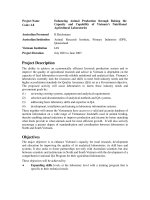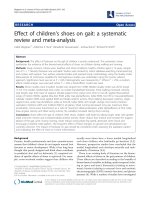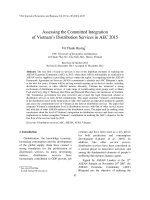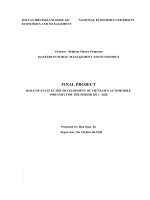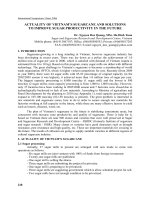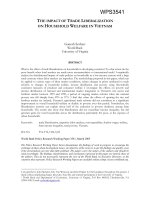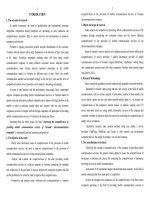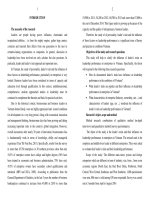The effect of trade openness on the profitability of vietnam’s food processing companies
Bạn đang xem bản rút gọn của tài liệu. Xem và tải ngay bản đầy đủ của tài liệu tại đây (139.11 KB, 13 trang )
The Effect of Trade Openness on The Profitability of
Vietnam’s Food Processing Companies
Le Hai Ha
University of Economic and Technical Industries, Vietnam
Le Thanh Huyen
Thuong Mai University, Vietnam
Abstract
In the increasing trend of globalization, the trade openness is considered as one of important
external
factors impacting on the firm’s performance. In a context where international business is strongly
boosted, the
level of openness of market can create opportunities for companies to improve their profit.
Knowledge of the
relationship between ability of international expansion and firm performance has been a
significant concern
for theory development in the strategy and international business literature. Based on this
theory, in order to
evaluate its influence, the research examined the effect of trade openness on the profitability of
Vietnamese
food processing companies over five - year period from 2013 to 2017. With the data collected from
companies
in this industry in Vietnam, we used regression analysis method to show the effect of the level
of trade
openness on firm profitability. However, according to our research, there is no
relationship between
dependent variable (ROA, ROE) and the independent variable (openness index). In fact, there is no
statistically
significant correlation between these variables.
Keywords: Food processing companies, Trade openness, Profitability.
1. Introduction
Always do managers spend a lot of attention on firm profitability, because it plays an
important role in the structure and growth of companies. As a result, it can lead to the high
performance and success of an organization. Based on enhancing the profitability, a company
can also increase its reputation. Consequently, maximizing the profits of firm becomes one in
all the most goals of leaders.
There are many ways to achieve that aim, but no manager can ignore the impact of an
external factor named trade openness. In the trend of globalization, it is able to create
numerous opportunities to grow for companies through import and export activities which can
easily grow their profit. Therefore, improving the trade-to-Gross Domestic Product (GDP) ratio
can be a manner to develop the domestic economy.
Vietnam is an agricultural country, as a consequence, the food processing industry is one of
top prioritized sectors. Therefore, food processing companies have a solid ground to develop. In
order to reach success and become the backbone of Vietnamese economy, their main objective
is the maximization of profit which is able to cause the maximization of shareholders wealth.
With this purpose, that Government pays attention to trade openness is necessary. Our study
focuses on the impact of openness index on their gain. Examining many relationships can
provide an overview about their capacity to create profit. Reasonable trade-to-GDP ratio
becomes especially helpful to companies considering a growth based on boosting sales, when
they realize that the production can be increased by expanding market. The goal of our
research is to ascertain the relationship between openness index and profitability in
Vietnamese food processing industry.
221
The hypothesis that the openness index does significantly impact on the level of profit of
food processing sector in Vietnam. The H2 there is no significant relationship between
openness index and profitability.
2. Literature review
2.1. Concept of the relationship between international business and economic
growth
Gianni De, Honohan & Ize (2003) defined international business as business activities across
the frontiers that is with the rest of the world. Therefore, it can play an important role in
enhancing the economic growth at large, and productivity in particular. Historical validation has
showed that countries having internationally actives are prone to be more productive than
countries which rely only on the domestic market. However, its benefits for economic growth
and development are difficult to estimate. These authors found out that international business
deals with the economic and financial interdependences in economic and financial activities
among countries. In addition, international business is integral for shaping economic and social
performance and prospects of nations around the world, particularly those of developing
countries. Nevertheless, there are also a lot of risks in business activities across the frontiers,
including economic risk, political risk, country buyer and seller risk, commercial risk, culture
difference, lack of knowledge, overseas markets, language barriers corruption in business and
natural risks, which create the problems for the foreigner investors and firms’ leaders.
Consequently, the influence of international on growth has been being debatable.
Economic globalization is the integration process of numerous economies of the world where
any hindrances in the free flow of goods and services, technology, capital and even labor or
human capital is eliminated (Sonia and Rajeev, 2009). With the international business,
individual firms and corporate organizations can transact businesses worldwide without
restrictions.
2.2. Concept of the relationship between economic growth, profitability of firm
and openness index
(Pitelis, 2003). Growth is not a purpose itself, but rather an endogenous outcome of intrafirm knowledge generation and a means of achieving maximal possible long-run profits.
Edith Penrose (1959), in her book named “The Theory of the Growth of the Firm”, does not
indicate the discrepancy between growth and profitability into account. Her point of view is
similar to a lot of previous researches, it is that profit and growth in the long term could be
seen as equivalent, and companies pursue the growth for long-run development. However,
according to Pensore, growth is not the ultimate aim of a firm. She did not count the
opportunity cost of growth, and did not consider the differences between profit and growth.
According to Montgomery and Wernerfelt (1988), in order to reach goal of growth, comparing to
expanding product, a company should spend attention on foreign markets based on its existing
product that has success in its own country and is facing to the saturation in the current market,
because new activities have a close relation to its current activities, thus, they require only a simple
replication or relatively easy extension of the current knowledge. In other words, they can take use
of existing background in acquiring new markets.
The traditional Ricardian-Hecksher-Ohlin trade theory shows that openness to international
trade leads only a one-time rise in output, but it does not suggest the long-run growth. The
neoclassical growth model points out that the long-run growth rate of per capita output is
determined by the exogenous technological progress. The newer endogenous growth theories
spend attention on implications of trade openness on growth in the long run, because openness
improves the transmission of technology through providing communication with foreign
counterparts, boosting domestic resources towards more intensive research sectors and grows
market size (see Rivera-Batiz and Romer (1991) and Grossman and Helpman (1991,
222
Chapters 6 and 9)). However, these models do not necessarily predict that openness results to
economic growth in all circumstances and for all countries.
Edwards (1993) and Rodrik and Rodr´ıguez (2000). The strong results in favour of openness
may arise from model misspecification and/or openness measures may be acting as a proxy for
other macroeconomic policies or other important factors such as institutions and geography. In
conclusion, the cross-country studies can suffer from lack of robust and convincing evidence on
the openness-growth connection and this issue is still highly controversial.
In a citation count of the most cited papers dealing with openness and growth published
after 1992, the four most cited papers were concerned with cross-national statistical evidence
connecting trade and growth, and all stated finding a positive association between economic
integration and growth. In 2001, Dani Rodrik and Rodríguez carried out a systematic critique of
this evidence. In their point of view, the results in these papers either derived from the fact
that the openness indicators used were not appropriately measuring openness (while more
appropriate indicators in fact failed to deliver a significant association) or that the papers in
question had made questionable methodological choices. Using the same data than the
authors of these papers, they showed that correcting for these shortcomings in measurement
and methods made the significance of the results go away
Using broader databases and cross-section or panel-data estimations, Freund and Bolaky
(2008) and Chang et al. (2009) also point out that trade openness has a positive influence on
income and that this positive relationship is enhanced by complementary policies. Many
different measures of trade openness have been proposed and used in empirical analyses of
the relationship between openness and growth.
As argued by Lee et al. (2004), all measures of openness are generally closely linked to the
growth rate. Hence, it is likely that all measures of openness are jointly endogenous with
economic growth, which may cause biases in estimation resulting from simultaneous or reverse
causation. Various methods have been used to remedy this problem and there is still a debate
among scientists about which method is the most appropriate (see, e.g., Dollar and Kraay,
2004; and Lee et al., 2004).
Hausmann et al. (2007) proposed an analytical framework linking the type of goods (as
defined in terms of productivity level) a country specializes in to its rate of economic growth. In
order to test empirically for this relationship, they defined an index aiming at capturing the
productivity level (or the quality) of the basket of goods exported by each country. Using
various panel data estimators during the period 1962 – 2000, their growth regression showed
that countries exporting goods with higher productivity levels (or higher quality goods) have
higher growth performances. These results suggest that what countries export matters as
regards the growth effect of trade. Hence, our measurement of trade openness should consider
this quality dimension as a complement to the trade ratio (or the dependency) dimension.
On the other hand, monopolistic competition trade models with heterogeneous firms and
endogenous productivity provide theoretical support for a positive impact of trade openness on
growth. Indeed, the theory predicts a productivity improvement in the country due to the exit
of less efficient firms after trade liberalization -or a reduction in transport costs for example(e.g., Melitz, 2003). Furthermore, a higher share of the most productive firms will start
exporting, which translates into an increase in the variety of exports. As exporters are more
productive on average than domestic firms, an increase in exports variety can be associated to
rising country productivity.
Based on this literature, Feenstra and Kee (2008) developed a model allowing to link, across
countries and over time, relative export variety to total factor productivity using a GDP
function. They tested this relationship on the basis of exports to the US for a panel of 48
countries over the period 1980-2000 using three stages least squares regressions. Their
empirical results indicated that there is a positive and significant relationship between export
variety and average productivity. Furthermore, computing the gains from trade in the
monopolistic competition model of Melitz (2003), Feenstra (2010) shows that countries with a
greater export over GDP ratio will experience higher gains in terms of GDP per capita growth,
from export variety.
223
Once again, these results suggest that, in addition to the trade dependency ratio, the structure
of countries’ exports matters regarding the growth effect.
Andersen and Babula (2008) studied the openness-growth relationship based on looking at
the channels through which international trade affects economic growth. They consider capital
accumulation and productivity growth as two sources of growth in GDP per capita. They use
studies proving that the main factor of growth is not capital accumulation, and according to
their conclusion, the influences of trade on development mainly rely on productivity growth. In
a framework where growth is conducted by innovation, they give three factors creating the
impact of international business on growth. First, trade facilitates the access to foreign
intermediate inputs and technologies. Second, trade also rises the size of market for
companies, encouraging to continually research and development to manufacture new
products. Thirdly, trade allows for sharing general knowledge across geographical boundaries,
which allowing trading partners to have information, leading to facilitating the R&D process and
subsequent innovation.
Drawing from the Penrosian perspective that emphasizes the role of resources in firm
growth, in 2010, Liu Anran, with research named Organizational Slack, International Expansion,
and Firm Profitability, investigates whether and how firm slack resources influence the tradeoff
between international expansion and profitability. Particularly, author argues that there is an
inverted-U shaped curvilinear link between international expansion and firm profitability, and
uses resource-based view and agency theories to hypothesize how human and financial slacks
impact the relationship. In this research, the international expansion of Korean firms is
examined. Based on the data consisting of Korean firms that were listed on the Korea Stock
Exchange (KSE) between 1995 and 2007, this study indicates an inverted-U shaped nonlinear
relationship between international expansion and firm profitability exist.
In the research “The Effect of International Business on SMEs Growth in Nigeria”, Oladimeji
Moruff Sanjo, Muhammed Olaniyi Ibrahim (2017) examined the influence of international
business on SMEs growth in Nigeria. They collected secondary from the Nigerian Bureau of
Statistics and the Central Bank of Nigeria (CBN) annual report. The study shows that trade
openness and FDI have no significant effect on SMEs growth in Nigeria. It was also revealed
that the exchange rate has a significant influence on SMEs growth in Nigeria, and the effect of
exchange rate on SMEs growth is relatively strong. According to this study, the exchange rate
has a negative coefficient, in other words, the exchange rate reduces SMEs growth increases.
Moruff Sanjo Oladimeiji, Augusta Thereza, Ebodaghe, Peter Babatunde Shobayo (2017)
carried out a research named “Effect of globalization on small and medium enterprises (SMEs)
performance in Nigeria”. This paper investigates the influence of globalization on small and
medium enterprises (SMEs) performance in Nigeria. In this study, authors used the secondary
statistics data from CBN bulletin on relevant information. In order to examine the effect of
globalization on SMEs performance in Nigeria, a co-integration model was used. In addition,
three proxies were used to capture the activities of globalization; consisting of interest rate,
bank credit and trade openness. Output of SMEs to GDP was considered as a tool to measure
SMEs performance from 1992 to 2014. This study shows that the variables are not significant.
3. Research Methodology
The research study is analytical in nature and involved testing of hypotheses quantitatively. The
main content of this research approach is to find out a concise answer to the research questions
through the collection and analysis of information of firms. The study is mainly based on secondary
financial data including income statements, balance sheets, and cash flow statements of listed
sampled food processing firm, the data about import and export activities, GDP collected from
statistical yearbook of Vietnam, yearly report of Ministry of Industry and Trade od Socialist Republic
of Vietnam for period of 2013 to 2017. This offered an
224
improved understanding of the links existing among the variables. This section of the article
discusses the corporations and variables enclosed within the study.
3.1 Sample selection:
The study uses financial data of 20 food processing listed corporations in Vietnam between 2013
and 2017, the data about import and export activities, GDP as the sample, for instance, figures for
Profit before tax, Sales, import and export activities, GDP and others. Companies with missing data
are excluded from the study.
3.2 Measurement of Variables
This study identifies key variables including dependent and independent variables that
influence profitability of Vietnamese food processing sector. Openness index is an independent
variable, and we take Earning price per share ratio, Return on equity ratio and Return on assets
as measures of profitability to represent dependent variables.
Independent Variable:
We take one variable as independent variable:
The ratio of trade to GDP (openness index) - an indicator of trade 'openness' is a result of
globalization, and trade liberalization. The indicator is defined as follows
Openness = Import+Export
GDP
Dependent Variables:
We take three variables as dependent variables:
- Return on assets (ROA)is the value of the firm’s annual net income divided by the firm’s
total assets in book value. This ratio measure for the operating efficiency for the
company based on the firm’s generated profits from its total assets.
Return on equity (ROE) or return on capital is the ratio of net income of a business during a
year to its stockholders' equity during that year. It is a measure of gain of stockholders'
investments. It shows net income as percentage of shareholder equity. The formula to calculate
return on equity is:
Net profit after taxes
ROE =
Total shareholders' equity
The portion of a company's profit allocated to each outstanding share of common stock.
Earnings per share serve as an indicator of a company's profitability. Calculated as:
Earnings per share are generally considered to be the single most important variable in
determining a share's price. It is also a major component used to calculate the price-toearnings valuation ratio.
Net Income - Dividends on Preferred Stock
EPS =
Average Outstanding Shares
Research question
What is the impact of openness index on firm profitability?
What is the nature of impact whether positive or negative?
Research objectives:
The main objective of this research was to examine the influence of trade openness on firm
profitability.
The specific objectives of the study are:
(a) To examine the impact of trade openness in food processing sector.
225
(b) To test how fast the sample firms have been able to enhance their respective level of
efficiency if policies about trade openness are improved
It is expected that this study may contribute to better understand the efficiency of trade
openness for food processing companies in an emerging market like Vietnam.
Hypothesis development:
In the light of the above discussion, the present study expects relationship between fixed
assets and profitability. The main hypotheses to be tested in this study are as follows:
H1: Openness index has an association with Return on Equity
H2: Openness index has an association with Return on Assets
H3: Openness index has an association with Earning Per Share
3.3 Research model:
Profitability
Trade openness
Return On Equity
Openness index
Return On Asset
ROA = β0 + β1Openness+ ε
ROE = β0 + β1Openness+ ε
EPS = β0 + β1Openness+ ε
ROE = Return on Equity
ROA = Return on Assets
Openness = Openness index
α = Constant
Term β =
Coefficient Term ε
= Error term
4.
Earning Per Share
Data analysis and Discussion
4.1. Descriptive statistics
The table 1 shows the mean value of the variable return on asset is around 5 percent and
return on equity is around 7.2 percent with standard deviation of 0.098 and 0.356 respectively;
the mean value for openness index in that period is about 170%.
226
Table 1: Descriptive Statistics
Openness
ROA
ROE
EPS
Valid N (listwise)
4.2. Correlation between cash conversion cycle and profitability ratios
The Sig.(2-tailed) value tells if there is a statistically significant correlation between two
variables. In comparing trade openness from firm’s profitability, research compares openness
index as the trade openness, earning per share (EPS), returns on assets (ROA), returns on
equity (ROE) as firm’s profitability. As can be seen from the table 2, the sig.(2-tailed) value
between Openness index and ROA is .335, the value between Openness index and ROE is .853,
and the value between Openness index and EPS is .343. That result means that there is no
statistically significant correlation between Openness index and ROA, ROE or EPS. In other
words, there is no statistically significant correlation between Trade openness and Profitability
of Vietnamese food processing companies from 2013 to 2017.
Tabe 2: Correlations
Pearson Correlation
Sig. (2-tailed)
N
Pearson Correlation
Sig. (2-tailed)
N
Pearson Correlation
Sig. (2-tailed)
N
Pearson Correlation
Sig. (2-tailed)
Openness
ROA
ROE
EPS
N
**. Correlation is significant at the 0.01 level (2-tailed).
5. Conclusion
This paper studied the impact of trade openness on profitability in twenty Vietnam’s food
processing companies in the period of 2013 to 2017. Results showed that, there is no
significant correlation between Trade openness and Profitability of Vietnamese food processing
companies from 2013 to 2017. In other words, the theory about the effect of trade openness on
firm’s profitability is not suitable for Vietnamese food processing companies in that period.
References
Andersen, L. & Babula, R. (2008). The link between openness and long-run economic growth. Journal of International
Commerce and Economics, pp. 1–20.
Chang R., Kaltani L. and Loayza, N.V. (2009). Openness can be good for growth: the role of policy complementarities .
Journal of Development Economics, 90, p. 33-49.
Dollar, D. and Kraay, A. (2004). Trade, Growth, and Poverty. The Economic Journal, 114, February, p. 22-49
Edwards, S. (1993). Openness, trade liberalization, and growth in developing countries, Journal of Economic Literature
31(3): 1358–1393.
227
Edwards, S. (1998). Openness, productivity and growth: What do we really know?, Economic Journal 108(447): 383–
398.
Feenstra, R. C. (2010). Measuring the gains from trade under monopolistic competition. Canadian Journal of
Economics, 43 (1), p. 1-28 Freund, C. and Bolaky, B. (2008). Trade, regulations, and income. Journal of
development economics, 87, p. 309-321
Gianni De, N., Honohan, P., and Ize, A. (2003). Dollarization of the banking system: good or bad? IMF working paper.
Haussmann, R., Hwang, J. and Rodrik, D. (2007). What you export matters. Journal of Economic Growth, 12, p. 1-25
Montgomery, C. and Wernerfelt, B. (1988). Diversification, Ricardian Rents, and Tobin’s q. Bell Journal of Economics, 19,
623-630
Lee, H.Y., Ricci, L.A., and Rigobon, R. (2004). Once Again, Is Openness Good for Growth?. NBER Working Papers.
Cambridge: NBER.
Liu Anran (2010). Organizational Slack, International Expansion, and Firm Profitability. Dissertations and theses
Collection, Singapore Management University, Institutional Knowledge at Singapore Management University
Melitz, J.M. (2003). The impact of trade on intra-industry reallocations and aggregate industry productivity. Econometrical,
71(6), p. 1695–1725. Moruff Sanjo Oladimeiji, Augusta Thereza, Ebodaghe, Peter Babatunde Shobayo (2017). Effect of
globalization on small and medium enterprises
(SMEs) performance in Nigeria. International Journal of Entrepreneurial Knowledge, Vol 5, pp.56-65
Oladimeji Moruff Sanjo, Muhammed Olaniyi Ibrahim (2017). The Effect of International Business on SMEs Growth in
Nigeria. Journal of Competitiveness
Penrose, E. (1959). The Theory of the Growth of the Firm. Basil Blackwell: Oxford
Pitelis, Christo N. (2004). Edith Penrose and the Resource-based View of (International) Business Strategy. International
Business Review, 13:
523-532.
Pitelis, C. N. (2007). A Behavioral Resource-based View of the Firm: the Synergy of Cyert and March (1963) and
Penrose (1959). Organization Science, 18, 478-490.
Rivera-Batiz, L. A. and Romer, P. M. (1991). International trade with endogenous technological change, European Economic
Review: 971– 1001
Rodrik, D. and Rodr´ıguez, F. (2000). Trade policy and economic growth: A skeptic’s guide to the cross-national
evidence, in B. Bernanke and K.
Rogoff (eds), NBER Macroeconomics Annual, Vol. 15, MIT Press, Cambridge, USA, pp. 261–325.
Sonia, J., &Rajee, k. (2009). Globalization and its impact on small scale industries in India.PCMA Journal of Business,
1(2), 135-146.
228

